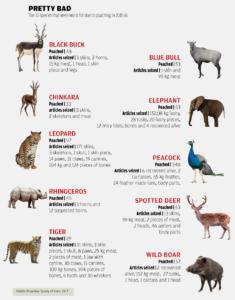In news
In order to control wildlife crime, the Uttarakhand government has created two Wildlife Crime Control Units
Key highlights
- To increase the efforts to control wildlife crime and act against poachers, the Uttarakhand government has created two seven-member Wildlife Crime Control Units for its administrative divisions of Garhwal and Kumaon.
- While the Garhwal unit has members from Rajaji Tiger Reserve and Kedarnath wildlife division, the Kumaun unit has members from Corbett Tiger Reserve and Bageshwar forest division.
- The proposed units will have jurisdiction spanning over an entire region to take action against poachers, register cases and pursue them in court, and maintain records of criminals and their wildlife crime history.
- These units will also act as a consultancy for the government on wildlife crimes
- Wildlife Crime Control Units also serve as nodal bodies sharing information and coordinating with the Union government’s Wildlife Crime Control Bureau
Why did the Uttarakhand government create Wildlife Crime Control Units?
Because the jurisdiction remains a challenge in prosecution in such cases as they are often dismissed in court when the defending party cites a jurisdiction issue.
With the new announcement, the state government has expanded the jurisdiction by creating two separate dedicated Wildlife Crime Control Units for the entire Garhwal and Kumaun regions. Each unit can now move in all the forest divisions of the region concerned. They can conduct raids in any division on information of wildlife crime, register cases, and pursue the matter in the court
Both the units can develop an intelligence network in any of the forest divisions of their jurisdiction area.
Another challenge faced by the state was sharing of data related to wildlife crimes, that is forest divisions were not sharing the information of criminals and were maintaining records of local divisional jurisdiction areas only. With this announcement, information of criminals and their crimes will be collected and maintained centrally at regional level and will be shared with all the divisional units concerned when required
Wildlife crime in India

Regulation of wildlife trade in India
- India has a strong legal and policy framework to regulate and restrict wildlife trade.
- Trade in over 1800 species of wild animals, plants and their derivative is prohibited under the Wildlife (Protection) Act, 1972.
- India is also a member of the CITES (Convention on International Trade in Endangered Species of Fauna and Flora) since 1976.
- CITES is an international agreement between governments that aims to ensure that international trade in specimens of wild animals and plants does not threaten their survival.
- CITES works by subjecting international trade in specimens of selected species listed on Appendices to certain controls.
















